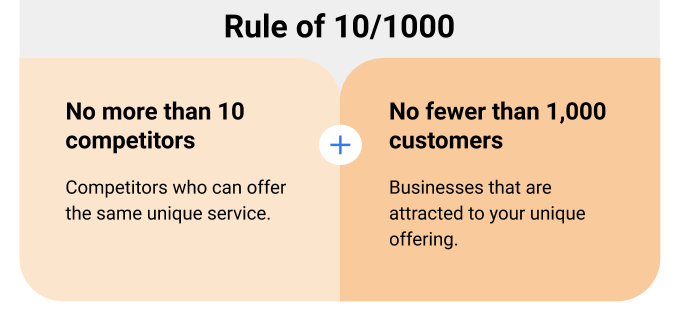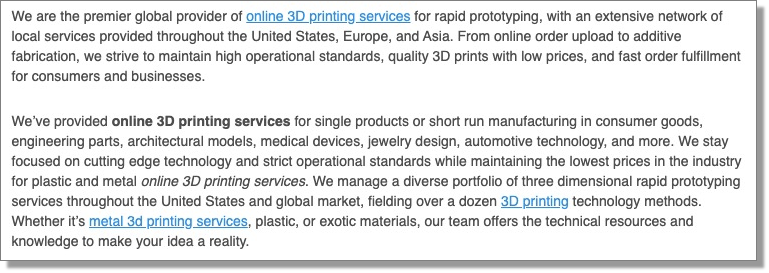Introduction
In this article, we’ll walk you through the benefits of choosing differentiated marketing positioning for your service bureau. The insights and methods detailed below were derived from the results of marketing campaigns we managed for service bureaus like Stratasys Direct, Scuplteo and others.
We hope the information below is useful to on-demand manufacturing service bureaus of all flavors: 3D printing, CNC machining, sheet metal, injection molding, prototyping and low volume manufacturing.
Benefits of Positioning
Generating leads for a manufacturing service bureau is challenging. The competition is fierce if you haven’t differentiated your shop to attract business. There are hundreds, maybe thousands, of service bureaus with similar capabilities. To make matters worse, you should expect your customers to shop around for services and solicit quotes from 3-5 service bureaus until they establish a trusted relationship with a provider.
Think about it from your customer’s perspective. How would you choose a service bureau with so many options to choose from?
The key to growth for your business is to focus on one or more areas of expertise that you can own, thus limiting competition for the jobs you do. Additionally, you will benefit from pricing power, marketing efficiency, targeted partnerships and building an unforgettable reputation for your areas of specialization.
Marketing efficiency. With good positioning, your marketing is significantly easier, and more fun. Since you’ve narrowed your marketing to target a specific ideal customer, you can efficiently find them and introduce your services. You will learn to speak their language and describe your services in terms they understand. This will make you more attractive to them.
Referrals. You’ll spend significant time building referral relationships to get the word out about your service bureau. However, it’s unlikely that the people you talk to will remember you unless there’s something distinct about what you have to offer. When someone learns about you for the first time, you want to position your service bureau in a way that is unique in their mind. For example, you might be the only business they know that specializes in 3D printed costumes. The next time they meet someone who needs a 3D printed costume your name will immediately come to mind. If you are one of several service bureaus they know of that all offer similar services, then your referral partners will forget about you.
Pricing. Discounting is a temporary crutch: it’s a habit of competing on price, not value. You don’t want to discount your services in hopes of reaching a broad audience – it’s much more valuable to market full-price necessities to a more specific market.
Partnerships. Once you’ve identified your ideal customer, it becomes obvious who the right partners are for your service bureau. You can send referrals to your partners depending on what a customer needs, and they will do the same in return.
Close rate. Nothing is more frustrating than talking to a potential customer and then never hearing from him/her again. When customers believe that you are uniquely qualified to serve them, they call you back!
Your Positioning Mindset
It’s easy to fall into the trap that narrowing your marketing is too limiting and will force you to turn down customers. You’ll need to replace this belief with the understanding that focusing your marketing on your ideal customer is a force multiplier that will exponentially improve your results.
It helps to realize that you couldn’t possibly work with every customer that needs your services; the market for your services is too large and the market’s needs are too diverse.
Working outside of your positioning
Just because you decided to focus your marketing on a particular ideal customer, there’s no need to limit yourself to only jobs with your emails customers. Your positioning guides your marketing, but you are free to take any job that falls within your capabilities.
Your Marketing Should Target a Subset of your Capabilities

Targeting More than One Ideal Customer
Larger service bureaus can target more than one ideal customer while maintaining the efficiency of their marketing programs. If you are just starting out, focus on one target market and ideal customer until you have a beachhead market or decide to change your marketing focus.
Positioning Your Shop
So, how do you position your shop? The key is to identify your competitive advantages and ideal customer profile. Think about what makes your shop unique and who would be most attracted to the unique value you can deliver.
Reality check: You might think you have the fastest turnaround times or the expertise to handle large metal prints. But, are these really competitive advantages? If your competitors make the same claim (true or not) and you have no way to convince the market that you are the true leader in this area, then it’s not a competitive advantage.
If you are small or just starting out, choose one industry to target and a specific type of customer in that industry. When you are larger, you can layer additional ideal customers on top of your existing targets.
Never Compete on Price
Low pricing is not a competitive advantage. It’s a race to the bottom that you cannot win. Discounting smells of desperation. Customers hire you for your expertise in process capabilities, designing complex features and materials. They know real experts don’t offer discounts. The only time we recommend discounting is to get your first few jobs. After that, discounting is a crutch that distracts you from crafting a service bureau that commands premium pricing.
Rule of 10/1000
Use this rule to guide your mindset around positioning. You want to offer a service that only 10 service bureaus can claim to provide AND make sure that you have at least 1,000 target customers out there who need this specific service.

Case Study: Bad Positioning
Here’s an example of a real (anonymous) service bureau failing to effectively position itself. This description of their services was pulled from their website.

The problem: This could describe almost any service bureau! Even worse, prospective customers reading this description won’t find anything unique or compelling to justify picking up the phone to call them.
This service bureau boasts “the lowest prices in the industry for plastic and metal online 3D printing services.” Discounting is lazy positioning.
Instead of highlighting specific regions where they can offer same-day pickup or fast delivery, they claim to offer local services everywhere.
Instead of calling out industries where they have strong case studies, they include a long list of industries they service.
Important: the customer reading about your service bureau doesn’t care that you have the capability to deliver a wide variety of jobs. She only cares that you can deliver HER job. She is looking for a reason to choose you and not your competitor. Don’t describe your firm with a laundry list of technical capabilities.
Focusing on Specific Types of Jobs Within Industries
Focusing your marketing on a specific type of job within an industry will help you stand out.
Imagine you’re a service bureau based in Los Angeles with a few previous jobs in the entertainment industry that you can reference. Now let’s narrow your focus even further. Let’s say you focus specifically on 3D printed costumes. You are still a full-service shop, but your marketing efforts will target entertainment companies that meet your ideal customer profile. This will be a short list, but that makes them easier to find. More on this later.
As your business expands, your access to marketing resources and customer case studies improves. You will learn to speak the language of your ideal customers, and the messaging on your website and marketing materials will reflect your growing expertise and experience.
Case Study: Good Positioning
Titanic Design is a full-service shop that focuses on 3D printed architectural models and trade show props. Their clear positioning makes them more valuable to their ideal customers.

As you dig into their site, it’s clear that they are a full service shop with the capability to serve customers in many different industries. But, they do a fabulous job building trust and credibility within their focus areas.
In fact, a friend of mine used them to print a number of large format parts. He told me he was convinced of their ability to print large parts because of the experience they demonstrated on their website printing large parts.
Developing Your Positioning
Developing positioning in a crowded market involves examining your competitive advantages, current customers, and past jobs.
Some questions to consider: What type of jobs are most successful for you? Which of your customers are particularly respected in their industries? Have you completed any impressive jobs worth bragging about? Do you have any rare equipment or materials that give you unique capabilities? What types of businesses are you most excited to work with and learn more about?
Think about the following:
- Location. Physical proximity to your customers is always attractive. Businesses prefer to work with local vendors when possible. What type of businesses are local to you?
- Case studies. Case studies build trust if they describe a job for a customer that is similar to your prospect. You should write as many case studies as you can (even for less remarkable jobs) because they reinforce your positioning and capability to deliver a specific type of job.
- Industry focus. Specializing in a specific industry is helpful, but it’s probably not enough. Some industries, like architecture and consumer products, already have a number of service bureaus so find your niche within the industry. Industries with a metal printing orientation, like aerospace and automotive, have less competition due to high equipment costs.
- Big names. If you have done any jobs (even small ones) for customers who are well-known in their industries, you may have struck gold. They don’t need to be the largest companies in their industries; they just need to be organizations that are well-known and respected. Write case studies about your work for them, mention them on your site, mention them on sales calls, mention them in your direct outreach. This “name dropping” may feel uncomfortable, but it inspires confidence and attracts customers.
- Lead time. Fast turnaround on jobs is only valuable if your lead time is better than your competitors. Maybe you are local to the customer so you can offer same-day pick up. Or you have a rare material on hand.
- Specialized materials. You may be able to base your positioning on your knowledge of metal printing, post processing capabilities or other specialized materials.
- Ease of ordering. Online ordering should be efficient and user-friendly. Use an online quoting tool like DigiFabster to reduce friction in the ordering process. Remember that many print jobs are rejected by service bureaus because of design issues. You may want to highlight your engineering services in your marketing.
- Firms experimenting with 3D printing. Many firms interested in additive manufacturing test the waters by contracting with a service firm before investing in in-house expertise and equipment. Catering specifically to these firms with engineering and training support could be a differentiator.
Leveraging your positioning
Once you have chosen your positioning and ideal customer, you are ready to deploy a marketing strategy based on your positioning.
Here are some marketing approaches to consider:
- Direct outreach. Create a short list of firms that would benefit most from your services. Reach out to them by email, LinkedIn, and phone to introduce them to your services. Of course, for this outreach to be successful you must offer value of some kind. You should offer something of value in every interaction with your prospects (usually your expertise).
- Educational content. Educating your target market is an incredibly effective marketing tool. Firms need help understanding the capabilities and limitations of on-demand manufacturing. You can help with technical information delivered as web content, white papers, case studies, email marketing, videos, webinars, and conference talks. Figure out the easiest way for you and your organization to demonstrate your expertise based on the type of content that comes naturally to you. Some people enjoy writing articles. Others would rather create videos or talk to engineers on a webinar. The key to this approach is to provide useful information to a targeted audience without selling. You can amplify your content with effective distribution and promotion.
- Industry groups and events. Service bureaus often attend manufacturing conferences to find customers. In some industries this works well. Automotive and aerospace companies send representatives to these shows to connect with service providers. However, it can be advantageous to examine your positioning closely to determine if your customers attend events outside of the manufacturing space. For example, architects and medical organizations go to their own conferences. You will have less competition at their industry events, so you may want to skip manufacturing events.
- Partnerships. What other types of businesses market to your ideal customers? Once you have a clear understanding of your target market, it’s easier to identify partnerships that could be mutually beneficial. Done right (with the spirit of mutual benefit) referral partnerships can be a growth engine for your service bureau.
Education as a Marketing Strategy
Does it make sense to educate your industry when many of them will hire a competitor? The answer is: absolutely. The alternative would be to let your competitors take the leadership role. When you deliver value through content or a helpful conversation, you earn trust, and customer growth will follow. Use educational content to stay at the top of your potential customers’ minds and to reinforce your positioning.
Final Thoughts
With thoughtful positioning, your marketing will be much more effective. You’ll identify the ideal customers for your service bureau and spend valuable marketing resources speaking directly to their needs and technical concerns. Your marketing will reinforce your expertise, trust, and credibility in the eyes of your target customer. Then, more of these businesses will choose you when shopping around for services.
The marketing and pricing benefits of positioning are derived from the targeted marketing approach that follows the positioning exercise. You will identify your ideal customers, create technical content to educate them and, in some cases, reach out to them directly.
This strategy works for both large and small service bureaus. As you grow, you may choose to layer additional ideal customer profiles on top of your initial positioning and expand your marketing efforts. Over time you will accumulate more case studies and learn to speak the languages of more industries.
Sometimes, positioning needs to change as your capabilities change. Or, your initial positioning isn’t working. Positioning isn’t set in stone. When your positioning fails to attract your ideal customers, make a change.
When you keep in mind the Rule of 10/1000 and focus your marketing, you’ll experience greater success in obtaining and maintaining quality customer relationships.
Interested in a no-cost strategy session to review your marketing efforts? Contact us.

